The Skylake Core i3 (51W) CPU Review: i3-6320, i3-6300 and i3-6100 Tested
by Ian Cutress on August 8, 2016 9:00 AM ESTGrand Theft Auto V
The highly anticipated iteration of the Grand Theft Auto franchise finally hit the shelves on April 14th 2015, with both AMD and NVIDIA in tow to help optimize the title. GTA doesn’t provide graphical presets, but opens up the options to users and extends the boundaries by pushing even the hardest systems to the limit using Rockstar’s Advanced Game Engine. Whether the user is flying high in the mountains with long draw distances or dealing with assorted trash in the city, when cranked up to maximum it creates stunning visuals but hard work for both the CPU and the GPU.
For our test we have scripted a version of the in-game benchmark, relying only on the final part which combines a flight scene along with an in-city drive-by followed by a tanker explosion. We record both the average frame rate and the percentage of frames under 60 FPS (16.6ms).
For this test we used the following settings with our graphics cards:
| Grand Theft Auto Settings | |||
| Resolution | Quality | ||
| Low GPU | Integrated Graphics | 1280x720 | Lowest |
| ASUS R7 240 1GB DDR3 | |||
| Medium GPU | MSI GTX 770 Lightning 2GB | 1920x1080 | Very High |
| MSI R9 285 Gaming 2G | |||
| High GPU | ASUS GTX 980 Strix 4GB | 1920x1080 | Very High |
| MSI R9 290X Gaming 4G | |||
Integrated Graphics
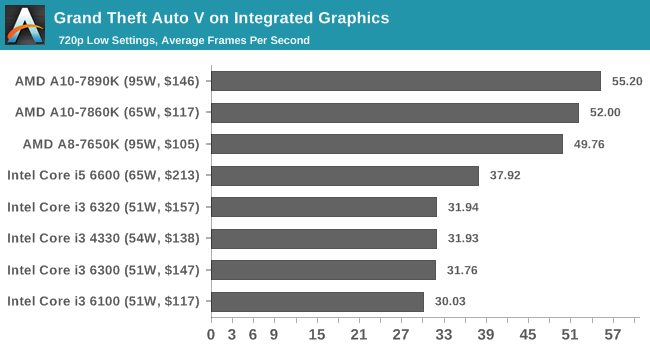
![Grand Theft Auto V on Integrated Graphics [Under 60 FPS]](https://images.anandtech.com/graphs/graph10543/83071.png)
The APUs take a large, almost double FPS lead for average frame rates, and again the Core i3 staircase shows that the L3 cache makes a difference. On the Low FPS graph, we see that none of the Intel CPUs make it above 60 FPS at any point, whereas the APUs can expect to see 15-30% of their time at or above 60 FPS.
Discrete Graphics
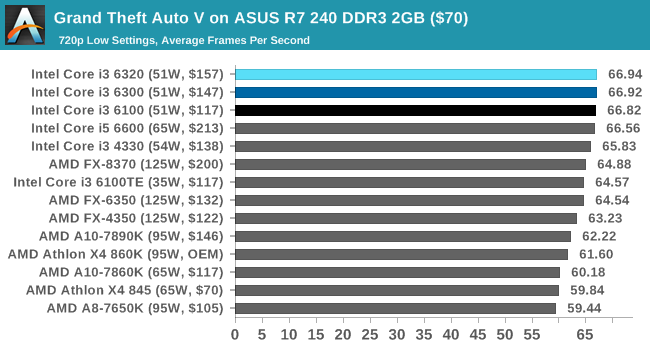
![Grand Theft Auto V on ASUS R7 240 DDR3 2GB ($70) [Under 60 FPS]](https://images.anandtech.com/graphs/graph10543/83079.png)
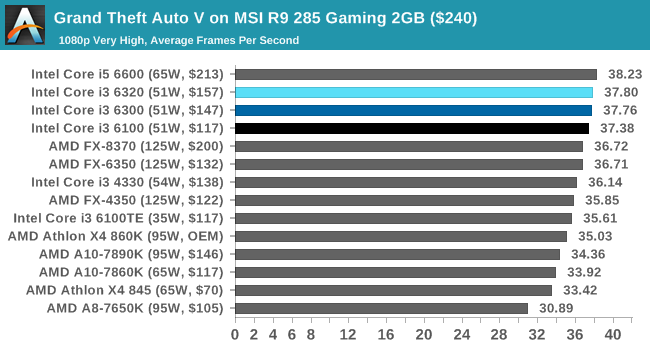
![Grand Theft Auto V on MSI R9 285 Gaming 2GB ($240) [Under 60 FPS]](https://images.anandtech.com/graphs/graph10543/83087.png)
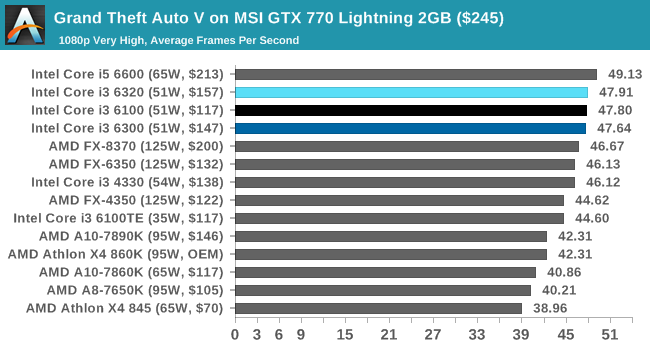
![Grand Theft Auto V on MSI GTX 770 Lightning 2GB ($245) [Under 60 FPS]](https://images.anandtech.com/graphs/graph10543/83095.png)
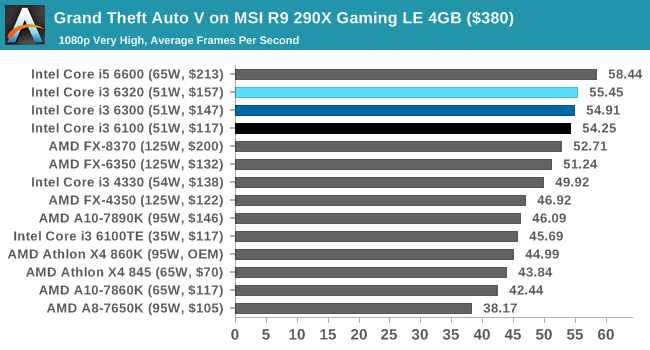
![Grand Theft Auto V on MSI R9 290X Gaming LE 4GB ($380) [Under 60 FPS]](https://images.anandtech.com/graphs/graph10543/83103.png)
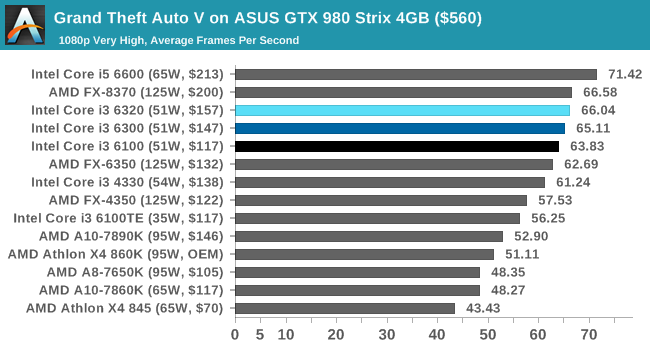
![Grand Theft Auto V on ASUS GTX 980 Strix 4GB ($560) [Under 60 FPS]](https://images.anandtech.com/graphs/graph10543/83113.png)
It's an onslaught of data, but clicking through to each graph will expand it in finer detail.
Again, with a discrete GPU, the Core i3s sit very pretty at the top of our graphs. In most cases, against similarly priced AMD CPUs, they can be from 5% to 20% quicker in average frame rates - the higher power the GPU, the more that it matters.
An interesting graph is the final one, with the GTX 980 and lookng at the percentage of frames over 16.6ms (i.e., the percentage time the game spends under 60 FPS). With the Core i3 parts, the game spends at least 50% of its time above 60 FPS running at 1080p Very High settings, however with similarly priced AMD APUs, this drops down to 15-25%. While running at V-Sync, this will be noticable. The FX CPUs get a better showing with the GTX 980, with the FX-6350 and the FX-8350 straddling the Core i3s for average frame rates and the 60 FPS metric.











94 Comments
View All Comments
Ratman6161 - Monday, August 8, 2016 - link
I don't understand your point. Did you note how many of the tests where the i3's (sometimes just the 6320 and sometimes all of them) beat the i5? Also look at certain gaming tests where an i3 with a better graphics card beats an i5 with a lesser graphics card...i.e. if you save $100 on the CPU and put that towords the graphics instead, you sometimes come out ahead overall.Finally, I know plenty of people who are just using their PC for web surfing, email, MS Office, etc where they would not notice any difference between an i3-6100 and an i5-6600K other than the fact that it cost almost $100 more. Sometimes good enough is good enough and thats where the i3 comes in.
extide - Monday, August 8, 2016 - link
Yeah, the i3's sometimes beat the i5's because when moving from the top end i3 to the bottom end i5 you lose quite a bit of frequency, but you gain two physical cores. So, if something is very lightly threaded then it may perform better on the i3.beginner99 - Tuesday, August 9, 2016 - link
True but for the mentioned usage you can step down to a Pentium or even Celeron and save even more and not notice much of a difference.BillBear - Sunday, August 14, 2016 - link
I agree. If Android can manage to leverage many small ARM cores for common tasks like web browsing, there is no excuse for Microsoft not being able to manage the same feat on Windows.http://www.anandtech.com/show/9518/the-mobile-cpu-...
xenol - Monday, August 8, 2016 - link
Please, do more lower-end CPU reviews! This data helps me understand how software and hardware play together more and more.To those thinking that it's sad that performance hasn't really increased in the past few years, maybe this is more of a sign that games are becoming efficient. If anything, this means your hardware will go a lot longer than before. Think about it, if the i5-2500K is still a viable CPU, think about how long an i5-6600K will last.
Philotech - Monday, August 8, 2016 - link
I'd love to see the same comparison for the mobile variants of the i3/i5 chips, in particular the 15W variants suitable for ultrabooks and MacBook Pros.Looks like for desktops, as a mainstream user there is no need to look beyond the i3. How about mobile? Looking at Intel's ARK database, there aren't that many 15w i3s (one, actually, 6100U), but a few i5s (four).
dave_the_nerd - Monday, August 8, 2016 - link
That seems tough - since they're soldering into the chassis, and different cooling can result in throttling and very different performance numbers even from the same chips. It'd be really hard to make a fair CPU-to-CPU comparison.Philotech - Monday, August 8, 2016 - link
Hm, you're right probably. Seeing how small the differences between the desktop i3s and i5 is, I'm wondering if it makes any sense at all to judge a laptop or ultrabook by its CPU, in particular taking into account your point, i.e. that probably cooling (and selecting a higher or lower TDP by the manufacturer) makes much more of a difference than the CPU model.extide - Monday, August 8, 2016 - link
Well, in the mobile chips the segmentation is different. In the desktop world going from i3 to i5 you gain two cores, lose hyper threading, and gain turbo boost.In the mobile chips everything has hyper threading. Going from i3 to i5 gains you turbo boost on a mobile chip and that can be pretty significant, because on those really low TDP chips they tend to have a pretty low base speed but the ones that can boost can usually boost up quite a bit. Going to an i7 in the 15w chips add's a bit more clockspeed and you will typically move from 3MB of L3 to 4MB of L3. The best value are the i5's in the mobile world because turbo boost helps a lot, but moving to an i7 with 4MB of L3 doesnt really gain that much performance, and can be pretty costly.
So, you can't really use these results to judge the differences between mobile i3's and i5's because they are quite different.
slickr - Monday, August 8, 2016 - link
I'm waiting for AMD's Zen CPU's before I upgrade my CPU. I'm running an older I5 3330, but so far nothing is really significantly faster for the same price I bought it at the time(180 euros). Especially in games the difference seems negligible and mostly comes down to GPU.So I'm waiting on Zen as my next likely upgrade.